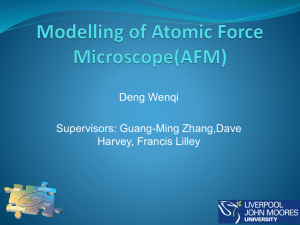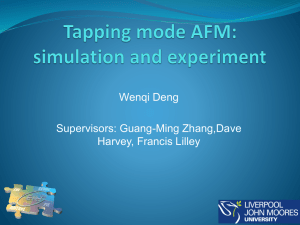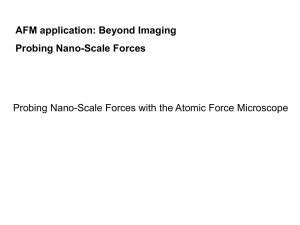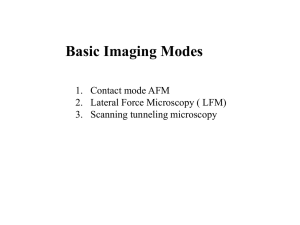ppt
advertisement
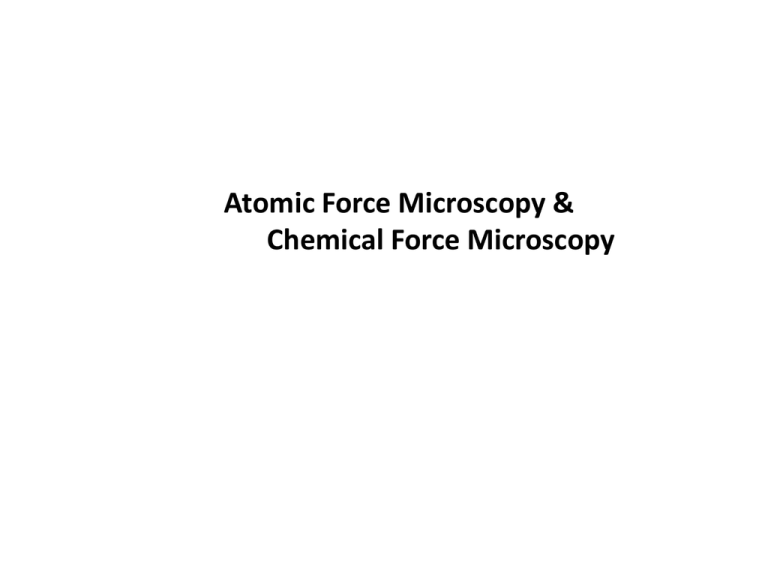
Atomic Force Microscopy & Chemical Force Microscopy • Biological systems can only be fully understood if their structure is known • Structural Biology : the science investigating the structure and function of the components of living systems. • Traditional methods - X-ray crystallography, NMR : Too complicated, limited size (200 Kd, 40 Kd) - Electron microscopy - Impossible for observation under physiological conditions AFM : Atomic force microscope • High resolution type of scanning probe microscope • Invented by Binnig, Quate, Gerber in 1986 • To determine the surface topography of native biomolecules at subnanometer resolution not only under physiological conditions, but while biological processes are at work. • One of the foremost tools for imaging, measuring, and manipulating matter at the nanoscale • High signal-to-noise (S/N) ratio : details topological information is not restricted to crystalline specimens. • Utilize a sharp probe moving over the surface of a sample in a raster scan. • The probe is a tip on the end of a cantilever which bends in response to the force between the tip and the sample surface Principle of AFM • Scan an object point by point using a cantilever tip • Determine the forces between the tip and the sample based on a deflection of the cantilever according to Hook’s law. • The cantilever obeys Hook’s law for small displacement, and the interaction force between the tip and the sample can be determined. • Measure the deflection using a laser spot reflected from the top of the cantilever into an array of photodiodes. Schematic of AFM using the light deflection mode • As the cantilever flexes, the light from the laser is reflected onto the photo-diode • Change in the bending of the cantilever is measured • The movement of the tip or sample is performed by an extremely precise positioning device made from piezoelectric ceramics, mostly in the form of a tube scanner. • The scanner moves the sample or the cantilever in x, y, and z direction at subangstrom resolution Force curve as a function of the distance between the tip and the surface : Van der waals force Van der waals force f(r) ~ -1/r6 +1/r12 10-7 ~10-11 N Feedback operation • If the tip were scanned at a constant height, the tip would collide with the surface, causing damage • A feedback mechanism is employed to adjust the tip-to sample distance to maintain a constant force between the tip and the sample • The sample is mounted on a piezoelectric tube that can move the sample in the z-direction for maintaining a constant force, and the x and y directions for scanning the sample. • Operation in two principle modes - With feedback control : the positioning piezo responds to any changes in force that are detected, and alter the tip-sample separation to restore the force to a predetermined value constant force mode a fairly faithful topographical image - Without feedback control : Constant height or deflection mode - Useful for imaging very flat sample at high resolution - A small amount of feedback-loop gain to avoid problems with thermal drift or damaging the tip and/or cantilever. Imaging modes • Contact mode (Static mode) • Dynamic force mode - Non-contact mode - Intermittent contact mode (Tapping mode) - Force modulation mode Contact mode • The most common method • The tip and sample remain in close contact, namely in the repulsive regime of the intermolecular force curve as the scanning proceeds • Repulsive force : 1~10 nN • Deflection of cantilever with a low spring constant • Determine the reflection of laser from the top of the cantilever using a photodiode • Alter the tip-sample separation to restore the force to a predetermined value scanner • Image the surface by analyzing the changes in z-direction Contact mode • Very sensitive to a small force • Measuring a displacement as small as 0.01nm • Image with high resolution • Damage of the sample and/or tip , cantilever • Large lateral forces on the sample as the tip is effectively dragged across the surface • Combined effects from the capillary forces of the water contamination layer Dynamic Modes • Distance between the tip and the sample : 2 – 30 nm • Attractive force : 0.1 ~ 0.01 nN • Vibration of cantilever around its resonance frequency Due to a too small force, it is impossible to determine directly the deflection of cantilever • • Measure the changes in the frequency (fo) of cantilever caused by interaction between the sample and cantilever • Oscillation of the cantilever : mechanical, magnetic or piezoelectric in air. • Oscillation in liquid is driven acoustically Non-contact mode • The tip remains at all times in the attractive part of the interaction curve, and scans above the surface with a relatively small amplitude. • The tip may jump into contact with the surface if the attractive forces exerted are greater than the spring constant of the cantilever. • Much stiffer cantilever is required • Resonant frequency : 150 – 300 kHz • Almost unusable in liquid system as the damping of the small cantilever oscillation by water or other liquids is too large and the signal disappears. • Low resolution with a minimum value of around 1 nm Typical Characteristics • Resolution similar to contact mode • Removal of the lateral forces → No surface damage • Sharp cantilever with a high resonance frequency and large spring constant (more stiff cantilever) Dynamic modes • Resonant frequency of cantilever feff = 1/2π (keff / m)1/2 K • • • eff : the spring constant of the cantilever, m : the mass of the cantilever As the tip approaches the surface, the effective mass of the cantilever will change due to the attractive forces acting on the point. Accordingly, the resonant frequency of the cantilever, feff, will change. Changes in the resonant frequency causes the variation in amplitude or the phase shift Two modes of detection are possible : amplitude or phase shift By defining the set point in terms of the signal amplitude or phase shift, the feedback loop is engaged. Intermittent contact mode : Tapping mode • The next most common mode • The cantilever moves rapidly with a large oscillation between the repulsive and attractive regimes of the force curve. • The maximum forces applied to the surface may be lower or higher than those experienced in the contact mode, but such forces are not applied constantly, lowering drag forces on the sample. • Stiff cantilever with resonant frequencies in the range of 200- 400 kHz To break free of water contamination : damping problem • The problem of capillary forces is removed. • The phase shift is highly sensitive to the tip-sample interaction and generates information on the mechanical properties of the sample. • Phase shifting may occur via adhesion between the tip and the sample or by a viscoelastic response of the sample. Force modulation mode • Combine the oscillation of the cantilever with scanning in the contact mode. • Low oscillation between 1 – 5 kHz • The information extracted concerns the mechanical and viscoelastic properties of the sample • Useful for imaging the sample containing composite materials. Cantilever • Material : Si, Si3N4 • Stiffness soft : contact mode (thickness : ~ 0.6㎛) stiff : dynamic force (thickness : ~ 4㎛) • Spring Constant (k) : 0.1 ~ 10 N/m • Resonance frequency : 10~100 kHz Artifacts related to tip size and shape • The sharpness of the scanning tip : One of the most important factors affecting the resolution • Tip convolution - Broadening :Occur when the radius of the tip curvature is comparable or greater than the size of the feature to be imaged. As the tip scans over the surface, the sides of the tip make contact before the apex, and the microscope begins to respond to the feature : Tip convolution. - Compression : The tip is over the feature - Interaction forces : Change in force interaction due to the chemical nature of the tip - Aspect ratio : when imaging steep sloped features Tip deconvolution effects Observed width W = (8dR)1/2 Resolution VEECO TESPA® VEECO TESPA-HAR® NANOWORLD SuperSharpSilicon® Tip length : 10 m Radius : 15~20 nm Tip length :10 m (last 2 m 7:1) Radius : 4~10 nm Tip length :10 m Radius : 2 nm Images of AFM Contact mode Dynamic force mode Chloroplast ATP synthase is revealed to be composed of 14 subunits AFM topographs of purple membrane from Halobacterium salinarium Purple membrane consists of 25 % lipid and 75 % bacteriorodopsin. The light driven proton pump comprises 7 transmembrane a-helices that surround the photoactive retinal AFM images of the cytoplasmic surface of the hexagonally packed intermediate layer of the bacterium Deinoccocus radiodurans Protruding protein cores Dip pen-nanolithography using AFM Lee et al. Science, 295, 1702-1705 (2002) MHA : 16-mercaptohexadecanoic acid Passivated by 11-mercaptoundecyl-tri(ethylene glycol) Chemical Force Microscope Force-Distance Analysis • When the tip is placed at a fixed point on the sample and move in the vertical direction to the surface and then retracted from the surface in place of scanning, the deflection of the cantilever can be measured as it moves. • The cantilever is in the repulsive, contact region of the cycle, and the adhesion interactions between the tip and the surface • The deflection of the cantilever will provide information on the mechanical properties of the material during the part of the approach and the retraction. (a) and (b) When the sample is hard and incompressible, as would be seen with glass, ceramics or metallic surfaces, the tip will simply approach the surface, jump into contact and then bend ; the retraction curve will be the same. (c) For more compressible samples, the curve will be expected to resemble that shown in (c) and information on the mechanical properties of the sample may be extracted . Force versus Distance • Adhesion force Fadh : R : size of the sphere (radius) W : work of adhesion Work of adhesion : Dupre equation - For a typical hydrocarbon, γw= 435, γHC = 108, γHC/W = 304 J/mol/A2 - For the 2.7 nN rupture force required to separate the complementary DNA interface, we calculate 1.6 * 10-4 J/m2 for the work of adhesion. Preparation of chemical tips SAMs (self-assembled monolayers) CFM probe tip Chemical force microscopy CH3/CH3 : 1.0+0.4 nN CH3/COOH : 0.3 + 0.2 nN Chemical force imaging : Chemical sensitive imaging • AFM probe tips are covered by particular chemical functional groups (-CH3, NH2, COOH or more exotic biological molecules) • Scanned over a sample to detect adhesion differences between the species on the tip and those on the surface of the sample • Chemical imaging of structures present on the surface due to differences in interactions between the tip and sample Small molecule DNA binding mode • • • • Cell replication and gene expression : specific DNA-protein interactions Blocking of the processes by small molecules : Therapeutic agents Binding modes of small molecules : Understanding of their functions and development of new drugs Binding through interactions, groove binding, and covalent attachment - Cisplatin ( cis-platinum diammine dichloride) : the cross-linking anti-cancer drug - Berenil : the anti-trypanosomal minor groove binder - Ethidium bromide : the intercalating dye Four Bases in DNA : A,G,C,T Pyrimidine (질소와 탄소로 구성된 6각형 고리 ) : thymine, cytosine Purine (질소와 탄소로 구성된 6각형과 5각형의 이중 고리) : adenine, guanine Sugar-Phosphate Backbone of DNA DNA structure (Space-filling Model) • 서로 반대 방향으로 되어 있는 2개의 사슬 한 가닥은 5’ 에서 3’ 으로 위에서 아래로 달리고 다른 가닥은 5’ 에서 3’ 으로 아래에서 위로 달린다. • 오른 나사 방향으로 꼬인 이중 나선 구조 • 염기간 상보결합 • 약 10개 뉴클레오티드 / 나선 한바퀴 : 3.4 nm • The cooperativity of the overstretching transition is strongly dependent on the base stacking in the DNA double helix • Different binding modes of small molecules cause different perturbations in base stacking Unique force curve profile Single molecule force spectroscopy : Mechanical property of DNA - ~ 50 pN : the worm-like chain model - 65-70 pN : transition from B-DNA to S-DNA Loss of the stacking interaction of DNA bases melting of the double helix breakage of hydrogen bonds -Rotation of DNA molecule to alleviate torsional strain a nick in one of the DNA strands - 150 pN : separation of double stranded DNA - Relaxation trace does not resemble the extension trace ( melting hysteresis) forced-induced melting Experimental conditions : 10 mM Tris buffer (pH 8.0) containing 150 mM NaCl and 1 mM EDTA A-, B-, and Z-form DNA Z-DNA Left-handed double helix Binding mode of small molecules with DNA - Digested phage DNA 2130 nm long fragment : - ~ 6260 bp, 50 % GC content Cisplatin acts by crosslinking DNA in several different ways, making it impossible for rapidly dividing cells to duplicate their DNA for mitosis. The damaged DNA sets off DNA repair mechanisms, which activate apoptosis when repair proves impossible. The chlorine undergoes slow displacement with water molecules forming a positively charged molecule which then crosslinks the DNA . Insertion of single dye molecule : Increase of the base pair rise by 3.4 A Unwinding of the double helix by 26o Berenil : 1,3-bis(4'-amidinophenyl)triazene Bind to the narrow minor groove of AT-rich regions through hydrogen bonding via the bis-amidinium groups at each molecule and van der Waals interactions The base pair unbinding forces : G-C (20 +3 pN), A-T (9 +3 pN) A Force-Based Protein Biochip Discrimination between specific and non specific interactions Top Surface (PDMS): DNA force sensor (14 pN) – Ligand/Protein – Cy3 B. Surface contact (10 min) and biomolecular interactions C. Surface separation D. Rupture of the weaker bond Cy3 remains connected to the stronger bond. E. Fluorescence upon the bottom surface No signal in non-binder and control spots Bottom Surface (Glass): Protein Microarray K. Blank et al. Proc. Natl. Acad. Sci. USA 100, 11356 (2003) Chemical force microscopy • Johnson-Kendall-Roberts (JKR) theory • JKR theory considers the effect of finite surface energy on the properties of the interface • For external load(Lext) and internal load(Lint) : friction coefficient Chemical force microscopy where 또는 Chemical force microscopy • External load(Lext), internal load(Lint)에 대해 : friction coefficient JKR theory에 의해 contact area of interface (radius a)는 elasticity (K = 3.4 * 109J/m3 for polystyrene) 의 함수로 나타낼 수 있다 Dynamic force mode
